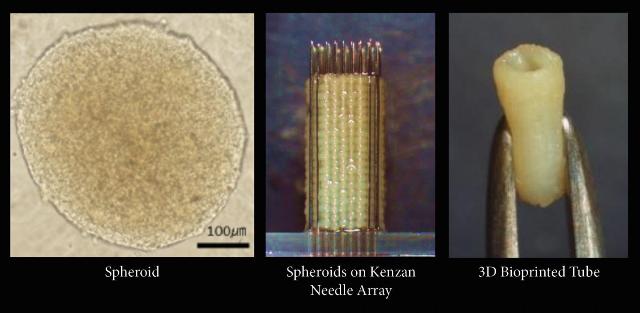Feb 5 2016
Advanced tissue-engineering services now exist in North America, according to Cell Applications, Inc. and Cyfuse Biomedical K.K. These services have been made available due to the development of a novel three-dimensional (3D) bioprinting method known as the “Kenzan Method.”
 The Kenzan Method constructs scaffold-free 3D tissue by lancing spheroids onto a fine needle array, or Kenzan. The spheroids can be constructed into small spheres, rods, sheets, tubes or other tissue configurations. As the engineered tissue fully matures, the individual spheroids fuse with one another into the desired pattern within a range of approximately 10x10x10 millimeter at 500 µm resolution. Cell Applications is utilizing its comprehensive primary cell bank and Cyfuse Biomedical's Regenova® 3D Bio Printer to create a powerful pay-for-service bioprinting model that makes scaffold-free tissue constructed by the Kenzan Method, available immediately to researchers in the North America for research use only. (Credit Cyfuse Biomedical)
The Kenzan Method constructs scaffold-free 3D tissue by lancing spheroids onto a fine needle array, or Kenzan. The spheroids can be constructed into small spheres, rods, sheets, tubes or other tissue configurations. As the engineered tissue fully matures, the individual spheroids fuse with one another into the desired pattern within a range of approximately 10x10x10 millimeter at 500 µm resolution. Cell Applications is utilizing its comprehensive primary cell bank and Cyfuse Biomedical's Regenova® 3D Bio Printer to create a powerful pay-for-service bioprinting model that makes scaffold-free tissue constructed by the Kenzan Method, available immediately to researchers in the North America for research use only. (Credit Cyfuse Biomedical)
Using an advanced robotic system called Cyfuse Biomedical's Regenova® 3D Bio Printer, which fabricates 3D tissue from cells, Cell Applications generated a pay-for-service bio-printing model. This powerful model makes scaffold-free tissue available for research work carried out by the US- and Canada-based scientists.
In addition to customized cell isolation and assay services, Cell Applications is now able to provide researchers with an integrated cell-engineering solution that utilizes our expansive primary cell bank and the innovative Kenzan bioprinting method. Having the Regenova 3D Bio Printer at our San Diego headquarters with our vast array of primary cells is a powerful combination. We're very pleased to offer researchers an end-to-end, customized solution for creating scaffold-free, 3D-engineered tissues that reduce costs by minimizing the lengthy processes typical in pharmaceutical drug discovery.
James Yu, Founder and CEO, Cell Applications
"The Regenova 3D Bio Printer, combined with Cell Applications' comprehensive, high-quality primary cell bank, offers researchers streamlined access to a nearly limitless selection of three dimensional tissues including those mimicking blood vessels, human neural tissue and liver constructs," said Koji Kuchiishi, CEO, Cyfuse Biomedical. "The collective strengths of both our companies will serve the growing demand for viable engineered tissues and accelerate scientific discovery in North America, taking us one step closer to making regenerative medicine a reality."
In contrast to existing bioprinters, the Regenova does not depend on scaffolding made biomaterials, like collagen or hydrogel, to construct 3D tissues. Alternatively, the instrument brings together 3D macroscopic tissue by creating cell aggregates, known as spheroids. These aggregates are formed one by one, and are lanced onto a fine needle array. The spheroids are guided by pre-programmed software, and they can be constructed into small spheres, sheets, rods, tubes or other tissue designs. The engineered tissue is allowed to thoroughly mature during a culturing process in a bioreactor chamber, so that the spheroids get fused with one another in any preferred form at 500 μm resolution within a range of about 10x10x10 mm. Several pieces of bioprinted tissue are then integrated to form much bigger constructs.
When the cells are matured, they organize themselves, creating reliable, firm tissue, which is later optimized by the design of the bioprinter's needle array. This permits circulation of the culture medium in an optimum manner. The Kenzan Method, which means "needle array" in Japanese, is a gentle process, and increases the amount of viable cells that are able to survive within the 3D construction. This is unlike bioprinting and scaffolding methods that employ high-velocity liquid flow and usually cause damage to cells, and also do not yield enough cell numbers.
Cell Applications, by employing quality-controlled processes, offers over 100 types of animal and human primary cells in about 900 configurations, including cryopreserved cells or freshly isolated cells, with superior viability. The company's custom services program facilitates isolation of more primary cell types. The gentle Kenzan Method is helpful for potentially delicate primary cells that maintain crucial properties of their original tissue systems, with no chemical or genetic modification. Such primary cells are of more physiological relevance than immortalized cell lines. In Japan, Cyfuse Biomedical have collaborated with research universities for the application of the Kenzan Method, and the company’s partnership with Cell Applications denotes the first use of the Regenova 3D Bio Printer outside of Japan.
The Kenzan Method has been utilized and evaluated by researchers working at academic research institutions, and biopharmaceutical companies for their research projects aimed at creating nerve, blood vessels, and functional liver-like tissues. Other possible uses are pancreatic islets and cardiac muscles, as well as tissues in the skin, trachea, digestive system, urologic, and spinal cord for drug screening, regenerative medicine research, and other research work in academic, biotechnological, pharmaceutical and cosmeceutical fields.